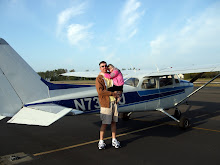 1.5hrs – Making the position calls, pattern work, steep turns, and intro to the sectional, airport/facility directory, online resources, and navigation.
1.5hrs – Making the position calls, pattern work, steep turns, and intro to the sectional, airport/facility directory, online resources, and navigation.Prior to takeoff, we spent a few minutes looking over and discussing the sectional, airnav, and the weather reports. It was my task (in addition to flying of course) to navigate from 7S3 to MMV, make the position calls, and determine how to enter the pattern based on our arrival direction and the active runway. One minor slip on the first call to McMinnville, but pretty smooth thereafter. I’ve been practicing by running through the calls in my head.
We worked on a couple of steep turns (45 degree bank angle). My altitude and bank angle varied some, but on the second time around to the left, I did manage to hit my own wake, which means that I ended at the same altitude that I began. Steep turns to the right seem a little more difficult.
I managed to navigate our way to McMinnville (It’s not far from Twin Oaks, so no huge feat, but a start) and overflew midfield for a descending right turn to enter the 45 for left traffic.
The first two approaches I started the base to final turn a little early, and was high on final (both I have tendency to do), but got back on track for some very respectable landings.
The third trip around, My CFI covered the altimeter. The pattern went well, was again a little high on final, but arrived smoothly.
The next pattern was without the airspeed indicator. I was a little nervous about this, but my CFI reminded me that the nose attitude, sound, and feel, will tell me what I need to know. This time we arrived with a little bump, but still better than most in previous lessons.
The fifth pattern was with no instruments (my CFI covered the whole panel with his coat). “You’re a VFR pilot, not IFR. Eyes need to be outside, only peeking inside to compare the instruments to what your eyes are telling you”. Okay I say, and around the pattern for a normal approach and landing. Not too bad. After cleaning everything up (so I thought) to make it a touch-and-go, I go to full throttle and my CFI pulls the mixture. “We’re not ready to take off. What did you miss?”. I’m looking around not seeing anything. “Trim?” He asks. Doh!! He had reminded me on the previous touch-and-go. The trim is used to releave pressure on the yoke, and correctly trimmed, you can maintain altitude, climbs, descents, and airspeed with hands off the yoke. The trim is a wheel that you roll up for nose down, and down for nose up. In the pattern in a 172, it works well to run one wheel of nose up (from top to bottom) as you begin the descent, and two wheels you are on final. If you don't retrim before the takeoff roll, the aircraft will pitch up quite high, and you'll need a lot of forward pressure on the yoke during climbout.
The next time around, trim was remembered.
Back to Twin Oaks. A little low by the downwind to base turn and had to add some power, then a tad high on final, but not too bad. I began to flare a little too early and started to drop in, but added a little power to help smooth the landing. It ended with a little bump, but since my CFI didn’t need to coach me through it, I happy with it.
After we shut down, my CFI was pointing out how my learning curve has steadily been increasing over the past several lessons, and the S word (solo) was spoken. He's thinking somewhere around the 20hr point based on my progress. Seems soon, especially since my first few lessons, at least, were spent in large part just getting comfortable with flying, but I do feel very satisfied with my progress as of late.
My next lesson will include a mini cross-country to Mulino (4S9), to practice a little navigation and reading the sectional, as well as visit somewhere new.


No comments:
Post a Comment